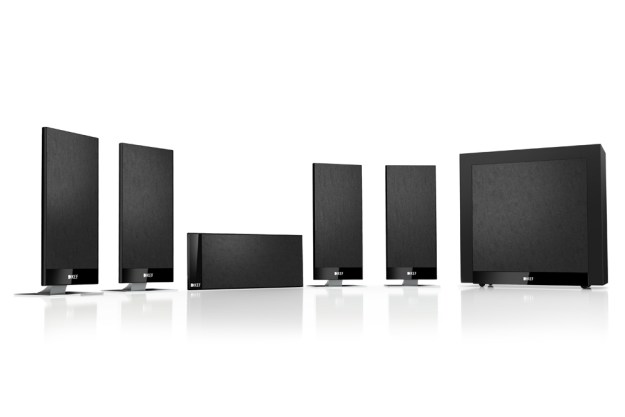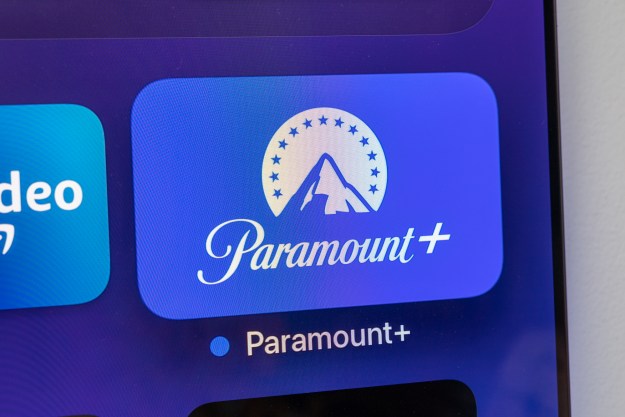
“The KEF T100 system does indeed deliver sound that’s in a league of its own and is the most impressive ultra-thin profile speaker system we’ve heard yet.”
- Class-leading, audiophile-quality accuracy and sound
- Equal parts sonic accuracy and musical faithfulness
- Super-neutral tonal balance sounds great with everything
- Spouse-pleasing, ultra-svelte form factor sounds great in a variety of locations
- Subwoofer could dig a bit deeper
- Non-standard speaker connections limit wiring flexibility
Very few loudspeaker brands have as rich a heritage as KEF. From its humble beginnings at the Kent Engineering and Foundry site (hence the initials “KEF”) in Kent, England, KEF has always focused on solid engineering as its guiding principle throughout its 50-year history.
Considering its legendary collaboration with the BBC on the LS 3/5a monitor, and proprietary technologies such as its Uni-Q concentric drivers, coupled-cavity loaded woofers and, more recently, activated carbon-loaded (ACE) enclosures, it’s easy to see how KEF’s R&D prowess has paid big dividends when it comes to cutting edge, audiophile-approved loudspeaker design.
KEF has since applied some of that engineering know-how toward a super-thin, on-wall friendly line of “lifestyle” panel-shaped speakers. Dubbed the T series, the lineup consists of both single-woofer and dual-woofer speaker options and two subwoofer models that can be purchased individually or as a part of a pre-packaged system. KEF sent us five of its single-woofer’d T-101 satellites and compact Kube-1 sub in a pre-packaged system it calls the T100.
KEF is so proud of its T series, it even boasts on its website that it is “…in a different league from any low-profile speaker you’ve ever heard.” That’s a bold claim, and with a street price of around $1,000, the T100 had better sound mighty impressive in order to compete with more traditionally-designed sub-sat pairings in the hotly-contested $1,000 price bracket. Does the KEF T100 system deliver on its promise?
Out of the box
What immediately grabs your attention when deboxing the T100 system is just how thin the T101 speakers actually are, especially given their somewhat dense, inert feel. With their skinny-mini profile of less than 1 ½-inches deep, the satellites are certainly thin enough to visually pair well with just about any flat-panel TV on the market.
Working our way around the satellite speakers, we took notice of some smart and eye-catching design touches and detail niceties, like anodized aluminum side trim and gloss-black accent panels. Sadly, the front grilles are not removable, negating our ability to view the high-tech hotness that is the T101’s bass/mid driver, which we’ll talk more about in a moment.
Pulling the Kube-1 subwoofer out of its box, we were again struck by the little sub’s heft and high level of fit and finish. Its permanent, wraparound cloth grille and gloss black top panel made for a harmonious aesthetic with the satellites.
Running our hands over T100 system’s many smooth and seamless surfaces, we couldn’t help but be impressed with its overall build quality. Even the included two-piece tabletop pedestal stands are nicely made and well-finished.
Features
As befits a KEF design, there’s more than meets the eye when it comes to the T100. As mentioned earlier, T101 satellite and T101C center speakers feature an all new, patent-pending, 4.5-inch, low-profile bass/midrange driver that dispenses with the traditional cone and central dome we’re all used to seeing. Instead, a twin-layer unit with a flat diaphragm and thin structural reinforcement ribs on its underside take its place. This design is said to be better rigidity throughout the driver’s frequency range, and allows it to act as a single, unified resonance-reducing unit. This driver’s mounting scheme also pulls double duty as an internal bracing unit for the enclosure. If you’re having trouble picturing what such a speaker would look like, you can check out KEF’s somewhat amusing video on the driver tech here.
The T-101’s 1-inch, aluminum dome tweeter features a bit of smart engineering as well. KEF has incorporated its “tangerine” waveguide across the tweeter’s front profile, said to help provide wider and more consistent dispersion. The tweeter also features a large voice coil for better heat dissipation and a stronger overall assembly. The clever part, however, lies in how the tweeter is vented: It’s channeled to the tweeter’s sides instead of the rear, also allowing for better dissipation in the thin enclosure.
Compared to the satellites, the included Kube-1 subwoofer is a more traditional design. A sealed enclosure houses a 200-watt, class D amplifier powering a single, side-firing, 8-inch active-drive woofer. A similarly-sized passive radiator opposite the woofer enhances the subwoofer’s output capabilities.
The T100 system includes a set of tabletop, pedestal-style stands and wall-mounting plates for all of the main speakers. Floor stands are also available for the main speakers should they be required.
Performance
Setting up the KEF T100 system was fairly straightforward. All we had to do was bolt together the two-piece pedestal stands and attach them to the speakers for tabletop or bookshelf placement, run the wires, tweak each speaker’s position, and fine tune the sub’s level for best integration. We tested the T100 system with a Marantz NR1602 A/V receiver, a Samsung BD-C5500 Blu-ray Player, HP Pavilion G6-2320DX laptop, and a Samsung UN40C6300 LED TV.
A quick note on the T100’s speaker connections: Like an increasing number of European manufacturers, KEF utilizes a pair of inset, “safety first” wire connection terminals. This means only banana plug-terminated or bare speaker wire can be used with the T100 system, so if you had your heart set on wires with spades, or have bulky terminations on your current wires, you’ll have to devise a different game plan for your wiring.

Thankfully, our patience was well-rewarded. The KEF T100 filled our ears with just the sort of accurate, refined sound you’d expect from an audiophile-oriented speaker system. Its overall sonic character can be described as clean, clear, and almost dead-neutral tonally, with an honest portrayal of instrumental and vocal timbres coupled to a highly-coherent midrange to treble region.
It’s that coherent and wide open midrange that first made our ears perk up and take notice. Listening to Bryn Terfel sing “Non Piu Andrai” from Mozart’s classic opera The Marriage of Figaro, every intricately delivered syllable and nuanced vocal inflection was clearly enunciated, serving to heighten the dramatic effect of this piece’s classic libretto.
What’s more, Joyce DiDonato’s brilliant vibrato from her album Rossini: Colbran, the Muse, was reproduced with all of its glorious texture and fine pitch control intact. In our experience, very few speakers in this system’s price range correctly reproduce operatic vocals. The KEF T100 system absolutely nailed it.
The KEF T100’s midrange to treble transition was buttery-smooth, full of natural and distortion-free decay. The woodblock taps throughout D’Angelo’s album, Brown Sugar, had some of the most realistic “clicks” we’ve ever heard, and cymbals had a fine shimmer and brilliant purity we’ve seldom heard from lifestyle-designed speakers. There may have been just a smidge too much bite in the lower treble region at times, but the T100 system had a way of revealing subtle high-frequency details without ever being ruthless about it.
In fact, it was the KEF system’s revealing nature coupled to its excellent listenability that impressed us the most. Pick any sort of music, regardless of its recording quality, and it’s easy to hear what the super-svelte KEF system does better than any other similarly-sized system: deliver that ineffable, effortless musicality that draws you into the music instead of the sound.
It’s this ability to sound so fundamentally correct that’s the rare feat. The KEF T100 system pulls off the neat trick of allowing your brain to move past the sound quality, good as it is, and instead focus on enjoying the music. The T100 system simply possesses a musical “rightness” that’s hard to describe, but once you hear it, you know what it is.
We spent many hours relishing in music from all different genres, including DeadMau5’ latest, >album title goes here< ,and the San Francisco Orchestra’s recording of Mahler’s 1st symphony. The T100 system always sounded honest and true to the source with each and every album we played.
We also had this same experience with films of all genres. From action movies like Iron Man and The Dark Knight Rises, to dialogue-driven rom-coms like Amelie and Happenstance, we appreciated time and time again how the well-balanced KEF system always made focusing on the performance instead of the sonics a supremely enjoyable experience.

Given their super-slim profile, and that KEF also offers optional floor stands, we were curious to hear how well the T101s would perform when placed away from the walls. We set them up on some makeshift stands in many different spots around the room and listened for the changes. It became immediately clear the T101s were engineered to sound excellent in a variety of locations, sounding open, neutral, and well-balanced regardless of where we placed them.
To be sure, they definitely sounded best nearer to room boundaries, where the upper bass and lower mids filled out nicely for the most even-handed response. But if you can’t or don’t need to place the T101’s near the walls, you’ll be happy to know they also work almost as well placed out into the room.
Conclusion
Going into this review, we honestly weren’t expecting much from the T100 system. Having owned and enjoyed various room-dominating KEF speakers throughout the years (such as the old-school 105/3s and wonderful Reference 2 and 3 models), we freely admit to being a bit biased towards this KEF system’s thin, lifestyle-friendly design. Luckily, our bias proved to be completely unfounded. The KEF T100 system does indeed deliver sound that’s in a league of its own and is the most impressive ultra-thin profile speaker system we’ve heard yet.
Were it not for the good-but-not-awesome Kube-1 subwoofer, we’d happily award this system a 9 for its winning combination of sonic and aesthetic goodness. As it stands, the KEFT100 system is still an absolute winner. There are speakers that deliver more sonic bells and whistles in some form or another, but if getting the most involving, communicative sound from the most spouse-friendly speakers is your highest priority, we bet you’ll absolutely love the T100 system.
Highs
- Class-leading, audiophile-quality accuracy and sound
- Equal parts sonic accuracy and musical faithfulness
- Super-neutral tonal balance sounds great with everything
- Spouse-pleasing, ultra-svelte form factor sounds great in a variety of locations
Lows
- Subwoofer could dig a bit deeper
- Non-standard speaker connections limit wiring flexibility







